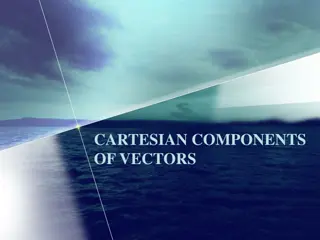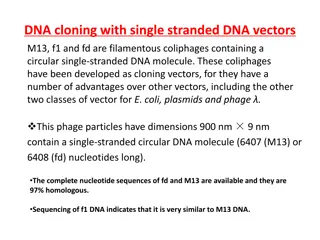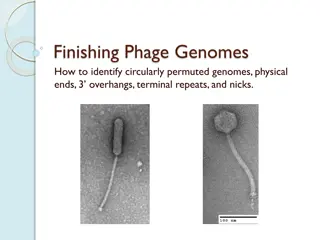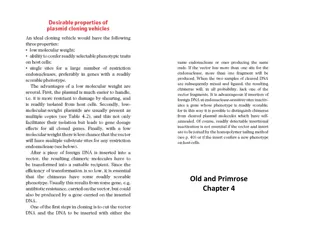Understanding Phage Vectors in Genetic Engineering
Phage vectors, utilized in genetic engineering, are bacteriophages capable of incorporating genes of interest into their genome. They have a higher DNA capacity compared to plasmids, making them ideal for creating genomic libraries. Bacteriophages like Lambda and M13 are commonly used for cloning vectors. The lytic and lysogenic life cycles of phages offer different mechanisms for gene replication and expression. Phage vectors provide efficient transformation and are valuable tools for genetic manipulation in research and biotechnology.
Uploaded on Sep 17, 2024 | 0 Views
Download Presentation

Please find below an Image/Link to download the presentation.
The content on the website is provided AS IS for your information and personal use only. It may not be sold, licensed, or shared on other websites without obtaining consent from the author. Download presentation by click this link. If you encounter any issues during the download, it is possible that the publisher has removed the file from their server.
E N D
Presentation Transcript
Phage Vectors Bacteriophages or phages are viruses that specifically infect bacteria. Viral vectors are those in which gene of interest is incorporated in the genome of virus. The phage particle attaches to the outer surface of bacterium and injects its DNA into the cell. The phage DNA is then replicated inside the host and its genes are expressed to make phage capsid proteins and new phage particles are assembled and released from the bacterium. Phage vectors can accommodate more DNA (up to 25 kb) than plasmids and are often used for preparation of genomic libraries. They also have higher transformation efficiency as compared to plasmids.
The main reason for seeking a different type of vector was the inability of plasmids such as pBR322 and pUC8 to handle DNA fragments greater than about 10 kb in size, larger inserts undergoing rearrangements or interfering with the plasmid replication system in such a way that the recombinant DNA molecules become lost from the host cells. The first attempts to develop vectors able to handle larger fragments of DNA centered on bacteriophage . Two bacteriophages namely, Lambda ( ) and M13 have been commonly used for construction of vectors for cloning in E. coli. The phage can have two modes of life cycles i.e. lytic and lysogenic. During lytic cycle, it replicates independently in the host cell and produces a large number of phage particles which are released by lysis of the host. Alternatively, it can take up lysogenic growth, meaning that it integrates its DNA into the bacterial chromosome and multiplies along with it.
The lysogenic infection cycle of bacteriophage The special feature of the lysogenic cycle is the insertion of the phage genome into the bacterium's chromosomal DNA, where it can remain quiescent for many generations.
Map of the chromosome of wild type The genes are not essential for phage growth and can be deleted or replaced without seriously impairing the infectious growth cycle
Bacteriophage infection is visualized as a plaque on a lawn of bacteria
Lambda () phage vectors Lambda is a temperate bacteriophage with a genome size of 48.5 kb. Its entire DNA sequence is known. The lambda genome is a linear, double-stranded molecule with single-stranded, complementary ends. These ends can hybridize with each other (and do so when the DNA is within an infected cell) and are thus termed cohesive (cos) sites. The genome is 48.5 kb, of which some 15 kb or so is optional in that it contains genes that are only needed for integration of the phage DNA into the E. coli chromosome. These segments can therefore be deleted without impairing the ability of the phage to infect bacteria and direct synthesis of new particles by the lytic cycle.
Two types of vector have been developed: Insertion vectors, in which part or all of the optional DNA has been removed and a unique restriction site introduced at some position within the trimmed down genome. Replacement vectors, in which the optional DNA is contained within a stuffer fragment, flanked by a pair of restriction sites, that is replaced when the DNA to be cloned is ligated into the vector. The genome is linear, but the two natural ends of the molecule have 12-nucleotide single-stranded overhangs, called cossites, which have complementary sequences and so can base-pair to one another.
There is a strict size requirement for the piece of DNA that goes into the phage head. That is, it should not be more than 52 kb and less than 38 kb.
Insertional vectors have one unique restriction site for a particular restriction enzyme and can accommodate 6-7 kb DNA. Examples of insertional vectors are gt10, gt11 and ZAP II. On the other hand, replacement vectors have two cleavage sites for a restriction enzyme and can accommodate up to 23 kb DNA. When vector is cut with a restriction endonuclease, a stuffer fragment is removed and replaced with a foreign DNA. Some examples of replacement vectors are EMBL3, EMBL3A, EMBL4, DASH, FIX, GEM11 and GEM12.
LAMBDA PHAGE VECTOR REVISITED Insertion V Replacement V
The lambda cI gene product - the lambda repressor. The lambda repressor acts to shut off lambda transcription. Insertion of foreign DNA into the cI coding sequence therefore inactivates this negative regulator and forces all recombinant phage to replicate via the lytic cycle. Non-recombinants can follow either the lytic or the lysogenic pathway. As noted previously, E. coli containing a lambda provirus (a lambda lysogen) are immune to subsequent phage infection and so can grow in the presence of the virus. This results in a 'cloudy plaque' morphology (cloudy appearance is due to the presence of lysogenic bacteria that continue to grow within the plaque). Recombinant phage carrying a foreign DNA insert are unable to lysogenize (no negative regulator) and therefore have a 'clear plaque' morphology (no lysogenic hosts growing within the plaque).
1. Which of the statement is incorrect with respect to Alpha (-) complementation? (A) One part of the lacZ gene (lacZ ) is present in the cloning vector (B) Another part is present in the host itself (C) The cloning vector is moved to host cell and transformants are selected on growth medium in the presence of IPTG, X-gal and antibiotic, blue colonies are observed (D) The cloning vector containing insert, is moved to host cell and transformants are selected on growth medium in the presence of IPTG, X-gal and antibiotic, blue colonies are observed 2. A cloning vector has two antibiotic resistance genes - for ampicillin and tetracycline. A foreign DNA is inserted into the tetracycline gene. Non- recombinants will survive on the growth medium containing (A) Ampicillin only (B) Tetracycline only (C) Both ampicillin and tetracycline (D) Neither ampicillin nor tetracycline
3. You are given a Lambda replacement vector of 43 Kb. It contains a central stuffer fragment of 14 Kb. Find the maximum size of the DNA fragment that can be cloned in the given vector. (A) 14 Kb (B) 43 Kb (C) 23 Kb (D) 29 Kb

























